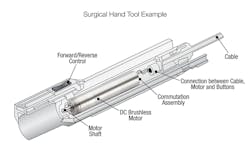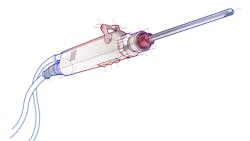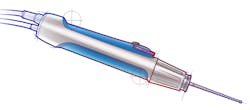How to Protect Your Powered Surgical Tools from Moisture and Corrosion
At a Glance:
- Potting, transfer molding and conformal coatings can protect components by encapsulating the electronics within a moisture-resistant barrier.
- Often the root cause for bearing, gear, commutation and electromagnetic circuit failures is moisture ingress at the distal end of the tool.
- To maximize a powered hand tool’s reliability, tool and motor designers should have a collaborative partnership.
Powered, reusable surgical tools are popular among surgeons thanks to their ability to reduce procedure times and improve patient outcomes. While an array of sensor, feedback and control components makes such advances possible, these parts are prone to corrosion from saline, steam sterilizations and other contaminants.
To ensure reliable performance over years of surgeries and reuse, device OEMs need to protect their tools against moisture ingress. Longer service life and failure-free performance can help lower the average cost per surgery and help justify the device’s sophistication.
A surgical tool’s motor presents numerous potential failure points:
- Bearing failure: Retainer failure, contamination, corrosion or loss of lubrication
- Gear failure: Wear, fatigue, corrosion or loss of lubrication
- Commutation failure: Non-functioning Hall switch, shorted connections or open connections
- Electromagnetic circuit failure: Open or shorted connections in the magnet wire or permanent magnet energy loss
Let’s look at how moisture and corrosion can compromise reusable surgical tools and offer mitigation strategies to ensure a long service life.
Preventing Moisture Ingress
Often the root cause for the above failure points is moisture ingress at the distal end of the tool. One way to prevent this situation is to apply a dynamic seal between the handpiece chassis and shaft of the motor. The dynamic seal is designed to provide a sharp seal lip that is held by an internal spring against the shaft. The seal is made from a special polymer blend designed for temperature and wear resistance. The seal assembly includes a mechanism—such as a stainless steel locking device, O-ring or axially compressed flange—that prevents the seal from rotating.
Designers should control runout and surface finish to ensure the seal is tight and long-lasting. Although the shaft seal can prevent moisture ingress at the shaft, it is not infallible. The seal lip and shaft surface will eventually wear, so plan for moisture to ultimately get past the seal. In addition, seals create friction and increase the tool’s running temperature.
Besides the distal end of the tool, mating points on the motor housing—such as between a motor and gearhead—are also susceptible to moisture. These ingress points can be sealed via a hermetic laser weld, sealed threads or O-rings. Other possible entry points are the electrical connections to the motor. The most effective approach to create a reliable design that withstands moisture and liquids is to work closely with the motor designer.
Avoiding Mechanical Component Failure
Lubrication washout can cause various mechanical failures. Lubrication is used to prevent both corrosion and metal-to-metal contact between components such as gear flanks and bearing elements. The lubricant should have a maximum listed operating temperature well above sterilization temperature, low water washout (per ASTM D1264 or similar) and favorable corrosion testing (per ASTM D5969 or similar).
Mechanical components like gears, shafts or bearings must be made of materials that resist fatigue, wear and corrosion. Precipitation hardened or austenitic stainless steels offer good protection against corrosion from saline or steam but may not have the required wear resistance for all components.
Martensitic stainless steels, which have lower chromium content than the austenitic grades, has less corrosion resistance but increased strength and surface hardness, making it suitable for components in metal-to-metal contact such as bearings and gears. Newer materials with nitrogen, nickel and molybdenum additions at somewhat lower carbon levels have also produced martensitic stainless steels with improved corrosion resistance.
It may be feasible to design with alternative materials to stainless, improving both corrosion and wear resistance. Lightly loaded components, such as bearing retainers, can be made from polyetheretherketone (PEEK) or polyamide-imide (PAI). Cemented carbides or ceramics can also be considered—these have excellent corrosion and wear resistance, but are comparatively brittle. Bearings with elements made from silicon nitride or zirconium dioxide ceramics offer significant improvement in corrosion resistance over martensitic stainless-steel elements.
The Causes of Electrical Failure
Electrical failure occurs when the printed circuit board (PCB), Hall sensors or electrical connections fail—often due to moisture. Potting, transfer molding and conformal coatings can protect components by encapsulating the electronics within a moisture-resistant barrier.
Potting places the components inside a housing. A silicone compound or epoxy resin is poured over the assembly, filling the housing and covering the components. A vacuum may be applied to remove any trapped air before curing. When the liquid hardens, the components are encased and, along with the hardened compound, become part of the final product.
Transfer molding is similar to potting, except the encapsulating material may be a pre-heated solid. The components—with or without a housing—are loaded into a heated mold cavity and the encapsulated material is pressed into the mold. The heated mold ensures the flow remains liquid to achieve a complete fill. Once filled, the molded parts are cooled for thermoset curing.
In addition to providing moisture resistance, potting and transfer molding are desirable for temperature-sensitive devices or wherever vibration or impact resistance are required. They also provide strain relief for exposed wires.
Wires that lead into the potted or transfer molded assembly can create a leak path. Many wire jacket materials, such as PTFE, do not bond well with mold materials. One approach is to etch the jackets to improve adhesion. Etching is a chemical reaction that strips the fluorine from the carbon of the PTFE backbone and promotes its replacement with the organic species responsible for adhesion.
The etched surface is sensitive to humidity and light, so it must be stored appropriately and used quickly. In some cases a better solution may be to avoid the wire pathway altogether by replacing it with terminal pins. They bond well, can extend beyond the potting or mold material and they plug directly into a mating connector.
Conformal coating, such as Parylene, is applied as a vaporized gas and is the thinnest moisture-resistant coating available. It is virtually free of pinholes and voids. Disadvantages include a lack of vibration or impact resistance, lack of strain relief for wires and susceptibility to damage during assembly.
Why Magnetic Circuits Fail
Magnetic circuit failure can occur when the motor winding or permanent magnets are exposed to high temperatures or moisture. Magnet wires with high temperature and heavy-build insulation should be used, and the formed coils should be molded or potted similarly to the PCB.
Permanent magnets can corrode or demagnetize due to temperature and moisture. Sintered neodymium iron boron (NdFeB) magnets must be SH- or UH-grade and protected via electroplating or an epoxy coating. Samarium cobalt (SmCo) magnets can also be used to avoid corrosion and demagnetization problems.
It Pays to Collaborate with Your Motor Designer
Powered surgical hand tools are sophisticated devices, and the electric motors at the heart of these tools are susceptible to various failures due to the presence of moisture during surgeries or sterilizations. In recent years, motor designers have drastically improved moisture resistance in the event that moisture will eventually make its way to the motor.
To maximize the device’s reliability, the tool and motor designers should have a collaborative partnership.
Jon Culp is a principal engineer at Portescap.



